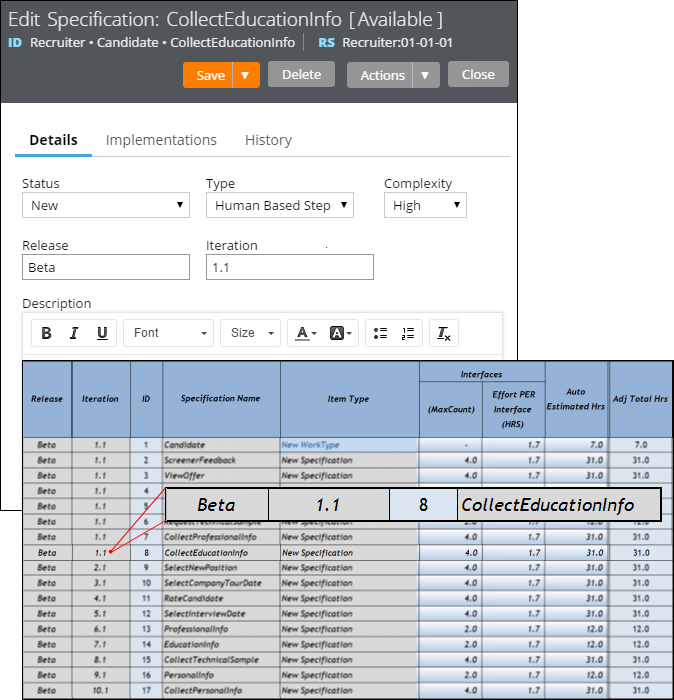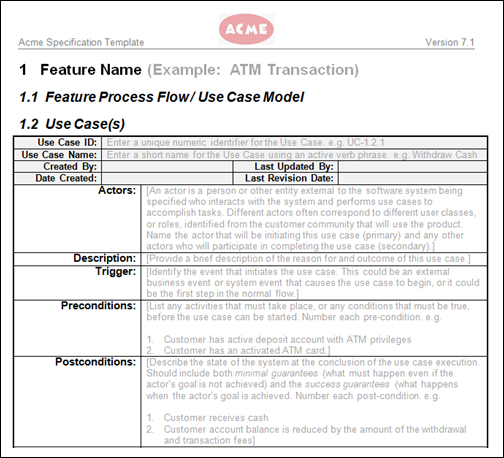Tracked changes persist between client sessions
Valid from Pega Version 7.1.7
The Microsoft Word native change tracking feature persists between client sessions for specifications. Enable this feature to facilitate collaborative reviews of your specifications with project stakeholders.
Inserting your specification updates as tracked changes allows you to:
- Provide visible markup to the next reviewer.
- Correlate edits to a specific user and time.
- Generate documents that include markup and comments.
Local settings, such as the colors you specify for markup, do not persist between clients.
For instructions on how to prevent markup and comments from appearing in generated documents, see Advanced options for editing specifications.
Add multiple attachments at once
Valid from Pega Version 7.1.7
You can now add more than one attachment to a requirement or specification at a time, without closing the Add/Edit Attachment modal dialog box. Use the traditional browse method to upload an attachment or drag and drop a local file, based on your needs. View and access your attachments from the Application Profile landing page, Requirement form, or Specification form.
Plan projects using release data
Valid from Pega Version 7.1.7
Requirements and specifications can now be mapped to a target release and iteration within a specific release. Populating these fields allows you to set and publish a release schedule through worksheets generated by the Sizing wizard. Access these fields from the Application Profile landing page or by opening any requirement or specification.

The Release and Iteration fields as they appear in a specification and a corresponding worksheet
The Sizing wizard incorporates values from the Release and Iteration fields for specifications only.
Specification type extended for decisioning users
Valid from Pega Version 7.1.7
Specifications now support a Decision Strategy Manager (DSM) type. This allows you to map your specifications to a decisioning component, such as a strategy or model. After you select an appropriate subtype and provide relevant metadata, you can run the Sizing wizard to incorporate these details into project sizing worksheets.

DSM specification details as they appear in the Specification form and Sizing wizard output
You must have access to Decision Management rulesets to create DSM specifications. For more information on specification types, refer to the Details tab of the Specification form. To view all specifications in your application, filtered by type, refer to the Application Profile landing page.
Add collections as linked implementations
Valid from Pega Version 7.1.7
You can now identify a collection or individual steps within a collection as an implementation of a specification. Linking specifications to rules allows you to more accurately convey your application design to project stakeholders. Use the Specifications tab on the Collection form to create these links.
To see all implementations for a given specification, refer to the Application Profile landing page or the Implementations tab of the Specification form.
Add project branding to generated documents
Valid from Pega Version 7.1.7
The standard Word Template for specification descriptions is now extensible. Using a customized template allows you to brand your generated documents with project-specific elements.
Specialize the Rule-Application-UseCase.pySpecificationDescription rule to:
- Include relevant images such as company logos.
- Define static text.
- Insert dynamic elements by merging clipboard values into field codes.

Generated document with custom company logo
Refer to Advanced options for editing specifications for instructions on how to override this template.
Define and manage features during application development
Valid from Pega Version 7.3
You can now define and manage the features and child features that you want to implement in your application. A feature represents any capability in your application that you want to promote to stakeholders during the application development process. When you develop an application and design case types, you can link each case type to top-level features in Designer Studio. In addition, you can associate existing rules with features, which maintains traceability and makes it easier for you to extend the application because you can identify the rules that are associated with each feature.
For more information, see Features.
Create connections to repositories
Valid from Pega Version 7.3
Pega® Platform can communicate with common repository technologies. Whenever an action creates a RAP, Pega Platform can browse, publish, or fetch artifacts: for example, when exporting an application, product, branch, or component. Repositories are instances of the Data-Repository class which holds all necessary connection information.
Pega Platform includes tools to connect with the following repository types:
- JFrog Artifactory
- Amazon S3
For more information, see Creating a JFrog Artifactory or Amazon S3 repository connection.
Associate rules and project management work items with features
Valid from Pega Version 7.3
You can now link a project management work item with a rule when you create a rule, check in a rule, and save a rule as a new rule, which automatically links the rule with any features that are associated with the project management work item. Associating project management work items, rules, and features maintains traceability and makes it easier for you to extend the application, because you can identify the rules that are associated with each feature. On the Application Overview landing page, you can also link existing rules directly to features in the Associated rules section of a feature.
For more information, see Associating existing rules with a feature.
Capture real-time feedback with Agile Workbench
Valid from Pega Version 7.3
Project stakeholders can use the new Agile Workbench tool to capture real-time feedback directly in an application, which can increase the efficiency of application development. You capture feedback by creating a user story, bug, or feedback item, and these work items can include video recordings of screens, annotated screen captures, file attachments, or URLs. In Designer Studio, you can configure Agile Workbench to integrate with Pega® Agile Studio so that bugs and user stories are synchronized between the two systems.
For more information, see:
- Pega Express 7.3 – Agile Workbench
- Pega Platform 7.3 – Agile Workbench

